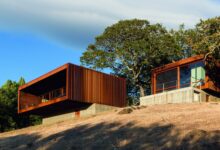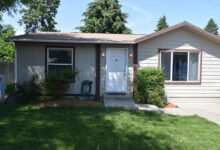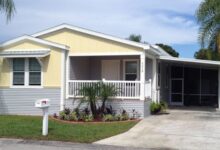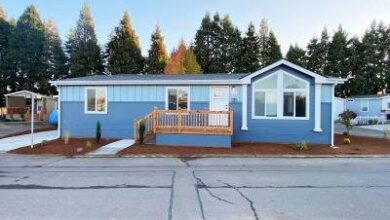Prefab Homes for Sale in Oregon
Prefab Homes for Sale in Oregon – Are you in the market for a new home in Oregon? Look no further than prefab homes! These modern, sustainable, and cost-effective dwellings have become increasingly popular in recent years. With their sleek designs, quick construction times, and affordable price tags, prefab homes offer an enticing alternative to traditional stick-built houses. In this article, we will explore everything you need to know about prefab homes for sale in Oregon, from their advantages and disadvantages to the top manufacturers and neighborhoods to consider.
Section 1: What Are Prefab Homes?
Prefabricated homes, often referred to as prefab homes, are houses that are constructed off-site in a factory setting and then transported to the desired location for final assembly. These homes are built using a controlled manufacturing process, where each component is precisely crafted to fit together seamlessly. There are several types of prefab homes available, including modular homes, panelized homes, and manufactured homes. Each type has its own unique construction process and characteristics.
Modular Homes
Modular homes are built in sections, or modules, in a factory. Each module is constructed with walls, floors, ceilings, and other necessary components. Once completed, the modules are transported to the building site and assembled on a foundation. The modules are then joined together to create a finished home. Modular homes offer the advantage of being highly customizable, allowing homeowners to choose from various floor plans, finishes, and features.
Panelized Homes
Panelized homes are constructed using pre-built wall panels, roof trusses, and floor systems that are manufactured in a factory. These pre-fabricated components are then transported to the building site and assembled on-site, similar to a puzzle. Panelized homes offer a faster construction process compared to traditional stick-built homes, as the pre-built components can be quickly and easily installed. This type of prefab home also allows for customization, giving homeowners the freedom to personalize their living space.
Manufactured Homes
Manufactured homes, also known as mobile homes, are built entirely in a factory and transported to the desired location. Unlike modular or panelized homes, manufactured homes are built on a steel chassis, which allows for easy transportation. Once the home is delivered and installed on a permanent foundation, it is considered a manufactured home. These homes are subject to the federal HUD (Housing and Urban Development) code, which sets construction and safety standards for manufactured homes.
Section 2: The Benefits of Prefab Homes
When considering purchasing a home in Oregon, prefab homes offer numerous benefits that make them an attractive option for potential buyers. From cost savings to energy efficiency, here are some of the advantages of choosing a prefab home:
Cost Savings
One of the key advantages of prefab homes is their cost-effectiveness. Prefabrication allows for efficient construction processes, shorter construction times, and reduced labor costs. Additionally, the controlled environment of the factory eliminates the risk of weather delays, further reducing costs. Overall, prefab homes tend to be more affordable compared to traditional stick-built homes while still offering high-quality construction.
Energy Efficiency
Prefab homes are designed with energy efficiency in mind. The manufacturing process allows for precise insulation installation, ensuring optimal thermal performance. Many prefab homes also come equipped with energy-efficient windows, doors, and appliances, further reducing energy consumption. With improved insulation and energy-efficient features, prefab homes in Oregon can help homeowners save on their energy bills while minimizing their environmental impact.
Reduced Environmental Impact
Prefab homes are inherently more sustainable than traditional homes. The controlled manufacturing process reduces waste and allows for better resource management. Additionally, many prefab home manufacturers prioritize the use of eco-friendly materials and practices, such as recycled or renewable materials and energy-efficient systems. By choosing a prefab home in Oregon, you can contribute to a more sustainable future while enjoying the benefits of a modern and stylish dwelling.
Section 3: Top Prefab Home Manufacturers in Oregon
When it comes to purchasing a prefab home in Oregon, it’s important to choose a reputable and experienced manufacturer. Here are some of the top prefab home manufacturers in the state:
Company A
Company A is known for its innovative designs and attention to detail. They offer a wide range of customizable floor plans and finishes, allowing homeowners to create a home that suits their unique style and needs. With a solid reputation and positive customer reviews, Company A is a top choice for prefab homes in Oregon.
Company B
Company B specializes in sustainable prefab homes that prioritize energy efficiency and environmental consciousness. Their homes are built using eco-friendly materials and incorporate energy-saving features, such as solar panels and high-performance insulation. With their commitment to sustainability and beautiful designs, Company B is a popular choice among eco-conscious homeowners in Oregon.
Company C
Company C stands out for its exceptional craftsmanship and attention to detail. They offer a variety of floor plans to suit different budgets and lifestyles. Their homes are known for their high-quality finishes and durable construction. With a strong reputation for customer satisfaction, Company C is a reliable choice for prefab homes in Oregon.
Section 4: Choosing the Right Neighborhood
When buying a prefab home in Oregon, it’s essential to consider the location and neighborhood. Here are some factors to consider when choosing the right neighborhood:
Location
The location of your prefab home in Oregon is crucial. Consider factors such as proximity to amenities, schools, and transportation. Think about your lifestyle and whether you prefer a suburban or urban setting. Research different neighborhoods to find the one that aligns with your preferences and needs.
Amenities and Facilities
Take into account the amenities and facilities available in the neighborhood. Are there parks, shopping centers, or recreational areas nearby? Access to essential services and leisure activities can greatly enhance your living experience in your prefab home.
Affordability
Consider the affordability of the neighborhood. Look into property values, property taxes, and homeowners association fees. Ensure that the neighborhood fits within your budget and offers long-term financial stability.
Community and Safety
Research the community and safety of the neighborhood. Look for low crime rates, strong community engagement, and a welcoming atmosphere. A safe and close-knit community can make your prefab home in Oregon truly feel like home.
Section 5: Financing Options for Prefab Homes
Financing a prefab home in Oregon is similar to financing a traditional home. Here are some financing options to consider:
Conventional Mortgage
A conventional mortgage is a popular option for financing a prefab home. It involves obtaining a loan from a bank or mortgage lender, with the home itself serving as collateral. To secure a conventional mortgage, you will need to meet certain credit and income requirements.
FHA Loan
The Federal Housing Administration (FHA) offers loans specifically designed for manufactured homes. FHA loans often have lower down payment requirements and more flexible credit criteria, making them accessible to a wider range of homebuyers.
USDA Loan
The United States Department of Agriculture (USDA) provides loans for rural development, including financing for prefab homes. USDA loans offer competitive interest rates and may require no down payment, making them an attractive option for those looking to purchase a prefab home in rural areas.
Grants and Incentives
Explore grants and incentives available for prefab homebuyers in Oregon. Some local and state government programs offer financial assistance or tax incentives to promote affordable housing and energy efficiency. Research these opportunities to potentially save money on your prefab home purchase.
Section 6: Tips for a Smooth Buying Process
Buying a prefab home in Oregon involves a series of steps. Here are some tips to ensure a smooth buying process:
Research and Planning
Start by doing thorough research on prefab homes, manufacturers, and neighborhoods in Oregon. Understand your budget and preferences to narrow down your options. Create a checklist of requirements and prioritize them to guide your decision-making.
Find a Reputable Realtor
Working with a knowledgeable realtor who specializes in prefab homes can greatly simplify the buying process. They can guide you through the various stages, from finding the right home to negotiating the purchase agreement.
Inspections and Due Diligence
Before finalizing the purchase, conduct thorough inspections of the prefab home. Hire professional inspectors to assess the structure, plumbing, electrical systems, and other important aspects. Additionally, review any warranties or guarantees provided by the manufacturer.
Understand the Purchase Agreement
Carefully review and understand the terms of the purchase agreement before signing. Ensure that it includes all the necessary details, such as the purchase price, payment schedule, and delivery timeline. Seek legal advice if needed to protect your interests.
Section 7: Frequently Asked Questions
Here are some common questions and concerns about prefab homes in Oregon:
Do I Need a Building Permit?
Yes, you will need a building permit to construct a prefabhome in Oregon. The process for obtaining a building permit may vary depending on the location and specific regulations of the county or city. It is important to check with the local building department to understand the requirements and procedures for obtaining a permit.
How Long Does It Take to Build a Prefab Home?
The construction timeline for a prefab home can vary depending on factors such as the complexity of the design, size of the home, and the manufacturer’s production schedule. Generally, prefab homes are known for their shorter construction times compared to traditional homes. From the initial design and customization process to the final assembly and finishing touches, the construction of a prefab home in Oregon can typically range from a few weeks to a few months.
Can I Customize the Design of a Prefab Home?
Yes, one of the advantages of prefab homes is the ability to customize the design according to your preferences. Many prefab home manufacturers offer a range of floor plans and design options to choose from. You can often select finishes, materials, and features that suit your style and needs. However, it is important to check with the manufacturer to understand the extent of customization options available and any associated costs.
Are Prefab Homes Durable and Long-Lasting?
Prefab homes are built to be durable and long-lasting. The components of prefab homes are manufactured in a controlled environment, ensuring high-quality construction. Additionally, many prefab homes are designed to meet or exceed building codes and standards for structural integrity and safety. With proper maintenance and care, a prefab home in Oregon can last for several decades, just like a traditional stick-built home.
Do Prefab Homes Hold Their Value?
Prefab homes in Oregon can hold their value well, just like traditional homes. Factors such as location, market conditions, and the overall condition of the home can influence its value over time. It is important to consider the resale value when purchasing a prefab home. Choosing a desirable neighborhood and investing in quality construction and finishes can help maintain and potentially increase the value of your prefab home.
Section 8: Case Studies: Inspiring Prefab Home Projects in Oregon
Take a look at these inspiring prefab home projects in Oregon:
The Smith Residence: A Modern Oasis in Portland
The Smith Residence, located in the heart of Portland, is a stunning example of modern prefab home design. This two-story home features clean lines, floor-to-ceiling windows, and a spacious open floor plan. The interior is beautifully finished with high-end materials and fixtures, creating a contemporary and luxurious living space. The Smith Residence showcases how prefab homes can seamlessly blend into urban environments while offering all the comforts of a custom-built home.
The Johnson Family Retreat: A Rustic Haven in Bend
The Johnson Family Retreat, nestled in the scenic city of Bend, exemplifies the versatility of prefab homes. This single-story cabin-style prefab home embraces a rustic aesthetic with its natural wood siding, exposed beams, and expansive deck. The interior boasts an open-concept layout, a cozy fireplace, and large windows that frame picturesque views of the surrounding landscape. The Johnson Family Retreat demonstrates how prefab homes can blend harmoniously with nature, creating a serene and inviting retreat.
Section 9: Exploring the Future of Prefab Homes
The prefab home industry is constantly evolving, and exciting innovations are shaping the future of this housing option in Oregon:
Advancements in Technology
With advancements in technology, prefab home construction is becoming more efficient and sustainable. Robotics and automation are being integrated into the manufacturing process, allowing for faster production and higher precision. Additionally, the use of advanced building materials and energy-efficient systems is becoming more prevalent, further enhancing the performance and sustainability of prefab homes.
Customization and Design Options
As the popularity of prefab homes continues to grow, manufacturers are expanding their customization and design options. Homebuyers can now choose from an extensive range of finishes, fixtures, and features to create a personalized living space. The future of prefab homes in Oregon will likely see even more design flexibility, allowing homeowners to create truly unique and tailored homes.
Integration of Smart Home Technology
Smart home technology is revolutionizing the way we live, and prefab homes are no exception. The future of prefab homes in Oregon will likely see the integration of advanced smart home systems, allowing homeowners to control various aspects of their homes, such as lighting, temperature, security, and entertainment, through their smartphones or voice commands. This integration of smart home technology will enhance convenience, comfort, and energy efficiency.
Section 10: Conclusion
Whether you are a first-time homebuyer or looking to downsize, prefab homes in Oregon offer a compelling solution. Their modern designs, cost savings, energy efficiency, and sustainability make them an attractive alternative to traditional stick-built homes. By considering the information provided in this comprehensive guide, you are well-equipped to make an informed decision and find the prefab home of your dreams in the beautiful state of Oregon. Embrace the future of housing and embark on an exciting journey to find your perfect prefab home in Oregon.









